Article for Susan.
This is a reprint from the other blog. I'm going to place it here because I can add the pictures into the blog itself.
This is the article I wrote for Susan's newsletter. A little long, but what the heck.
Top Twenty Trees and Shrubs
(My Article, My Choice)
Wayne Rucker
Trees and shrubs are the backbones of the residential landscape. The materials that the rest of the landscape will be designed around. So it is a good idea to put a little thought into your choices. The problem is that everyone you ask has a different opinion. So just to add to the confusion I decided to offer this list of my favorites to Susan for her newsletter.
Trees and shrubs in bareroot or balled-in-burlap should only be planted when they are in dormancy. Trees and shrubs in container can be planted any time the ground can be worked. Dig the hole three to five times the width of the root ball, and the same depth (a little more shallow in heavy clay). Place the plant in the hole and straighten it up. Replace the native soil, firming as you go, and fill to the soil line of the root ball. It is usually a good idea to stake a tree on the north and south, we live in Oklahoma, after all, and the wind is impressive. Water. Mulch the plant well. Enjoy.
Arbor day (or week) for Oklahoma is the last full week of March, the 19th through the 25th. National Arbor Day is April 28th.
Trees
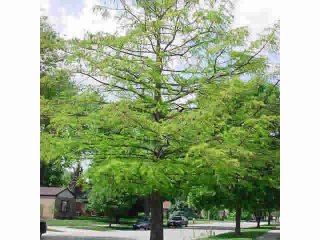 Bald Cypress (Taxodium distichum) 50 to 80 feet tall, 20 to 30 feet spread (large tree) The first year I plant these trees for a client, I can almost be sure that I'll get a call in the fall that their tree is dying. Most people assume they are evergreen, but while they are conifers, they are deciduous (lose their foliage in the fall). However, before they lose their foliage, they give a color show that has to be seen to be believed. The very fine needle like foliage turns a beautiful rust and stays for several weeks before it falls. A friend of mine in the business hates Bald Cypress because the leaves tend to form a mat on the ground under the trees, but I'm a big believer in mulch and natural nutrient replacement and Cypress are great at this. As the mat forms under the trees, (yes you may have to rake them back under there, we do live in Oklahoma, after all) it smothers any weeds that even think of sprouting, hold in the water and keep the soil warmer in the winter. Bald Cypress do need a lot of room and planted where they will receive full sun.
Bald Cypress (Taxodium distichum) 50 to 80 feet tall, 20 to 30 feet spread (large tree) The first year I plant these trees for a client, I can almost be sure that I'll get a call in the fall that their tree is dying. Most people assume they are evergreen, but while they are conifers, they are deciduous (lose their foliage in the fall). However, before they lose their foliage, they give a color show that has to be seen to be believed. The very fine needle like foliage turns a beautiful rust and stays for several weeks before it falls. A friend of mine in the business hates Bald Cypress because the leaves tend to form a mat on the ground under the trees, but I'm a big believer in mulch and natural nutrient replacement and Cypress are great at this. As the mat forms under the trees, (yes you may have to rake them back under there, we do live in Oklahoma, after all) it smothers any weeds that even think of sprouting, hold in the water and keep the soil warmer in the winter. Bald Cypress do need a lot of room and planted where they will receive full sun.
 Caddo Maple (Acer saccharum 'Caddo') 60 to 80 ft tall, 40 to 60 ft spread (large tree) Make sure that you get a Caddo maple. Sugar maples from the northeast U.S. are very short lived in our climate but Caddos are native to the southwestern part of Oklahoma and, as you can imagine, are very drought tolerant (when established). Slow growing, but with beautiful fall color, allow it plenty of space to grow into a mature shade tree.
Caddo Maple (Acer saccharum 'Caddo') 60 to 80 ft tall, 40 to 60 ft spread (large tree) Make sure that you get a Caddo maple. Sugar maples from the northeast U.S. are very short lived in our climate but Caddos are native to the southwestern part of Oklahoma and, as you can imagine, are very drought tolerant (when established). Slow growing, but with beautiful fall color, allow it plenty of space to grow into a mature shade tree.
 Chinese Pistache (Pistacia chinensis) 30 to 40 feet tall, 25 to 35 feet spread (medium sized tree) This is one of the best trees ever planted in the state of Oklahoma or anywhere else. Highly adaptable, able to take drought (once established), tolerant of alkaline soils and watering, and beautiful fall color. This is a perfect street tree. The male cultivars are slightly less messy, though the birds are usually happy to eat the metallic red or blue berries that come from the female flowers.
Chinese Pistache (Pistacia chinensis) 30 to 40 feet tall, 25 to 35 feet spread (medium sized tree) This is one of the best trees ever planted in the state of Oklahoma or anywhere else. Highly adaptable, able to take drought (once established), tolerant of alkaline soils and watering, and beautiful fall color. This is a perfect street tree. The male cultivars are slightly less messy, though the birds are usually happy to eat the metallic red or blue berries that come from the female flowers.
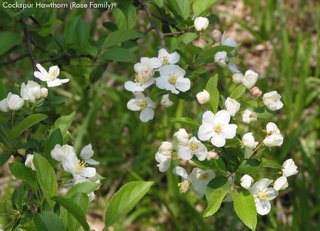 Cockspur Hawthorn (Crataegus crus-galli) 20 to 30 ft tall, 25 to 35 ft spread (medium tree) Four seasons of interest, early summer flowers becoming long lasting dark red berries that are loved by the birds, vibrant crimson fall color, a wonderful plant. One of the pluses for me are the curved thorns, 1 ½ to 3 inches long. A great plant for security planting. If you decide to use this tree in a hedgerow, be sure and plant it where no one will accidentally brush by it, people that try to get through it on their own deserve what they get.
Cockspur Hawthorn (Crataegus crus-galli) 20 to 30 ft tall, 25 to 35 ft spread (medium tree) Four seasons of interest, early summer flowers becoming long lasting dark red berries that are loved by the birds, vibrant crimson fall color, a wonderful plant. One of the pluses for me are the curved thorns, 1 ½ to 3 inches long. A great plant for security planting. If you decide to use this tree in a hedgerow, be sure and plant it where no one will accidentally brush by it, people that try to get through it on their own deserve what they get.
This is the article I wrote for Susan's newsletter. A little long, but what the heck.
Top Twenty Trees and Shrubs
(My Article, My Choice)
Wayne Rucker
Trees and shrubs are the backbones of the residential landscape. The materials that the rest of the landscape will be designed around. So it is a good idea to put a little thought into your choices. The problem is that everyone you ask has a different opinion. So just to add to the confusion I decided to offer this list of my favorites to Susan for her newsletter.
Trees and shrubs in bareroot or balled-in-burlap should only be planted when they are in dormancy. Trees and shrubs in container can be planted any time the ground can be worked. Dig the hole three to five times the width of the root ball, and the same depth (a little more shallow in heavy clay). Place the plant in the hole and straighten it up. Replace the native soil, firming as you go, and fill to the soil line of the root ball. It is usually a good idea to stake a tree on the north and south, we live in Oklahoma, after all, and the wind is impressive. Water. Mulch the plant well. Enjoy.
Arbor day (or week) for Oklahoma is the last full week of March, the 19th through the 25th. National Arbor Day is April 28th.
Trees
 Bald Cypress (Taxodium distichum) 50 to 80 feet tall, 20 to 30 feet spread (large tree) The first year I plant these trees for a client, I can almost be sure that I'll get a call in the fall that their tree is dying. Most people assume they are evergreen, but while they are conifers, they are deciduous (lose their foliage in the fall). However, before they lose their foliage, they give a color show that has to be seen to be believed. The very fine needle like foliage turns a beautiful rust and stays for several weeks before it falls. A friend of mine in the business hates Bald Cypress because the leaves tend to form a mat on the ground under the trees, but I'm a big believer in mulch and natural nutrient replacement and Cypress are great at this. As the mat forms under the trees, (yes you may have to rake them back under there, we do live in Oklahoma, after all) it smothers any weeds that even think of sprouting, hold in the water and keep the soil warmer in the winter. Bald Cypress do need a lot of room and planted where they will receive full sun.
Bald Cypress (Taxodium distichum) 50 to 80 feet tall, 20 to 30 feet spread (large tree) The first year I plant these trees for a client, I can almost be sure that I'll get a call in the fall that their tree is dying. Most people assume they are evergreen, but while they are conifers, they are deciduous (lose their foliage in the fall). However, before they lose their foliage, they give a color show that has to be seen to be believed. The very fine needle like foliage turns a beautiful rust and stays for several weeks before it falls. A friend of mine in the business hates Bald Cypress because the leaves tend to form a mat on the ground under the trees, but I'm a big believer in mulch and natural nutrient replacement and Cypress are great at this. As the mat forms under the trees, (yes you may have to rake them back under there, we do live in Oklahoma, after all) it smothers any weeds that even think of sprouting, hold in the water and keep the soil warmer in the winter. Bald Cypress do need a lot of room and planted where they will receive full sun. Caddo Maple (Acer saccharum 'Caddo') 60 to 80 ft tall, 40 to 60 ft spread (large tree) Make sure that you get a Caddo maple. Sugar maples from the northeast U.S. are very short lived in our climate but Caddos are native to the southwestern part of Oklahoma and, as you can imagine, are very drought tolerant (when established). Slow growing, but with beautiful fall color, allow it plenty of space to grow into a mature shade tree.
Caddo Maple (Acer saccharum 'Caddo') 60 to 80 ft tall, 40 to 60 ft spread (large tree) Make sure that you get a Caddo maple. Sugar maples from the northeast U.S. are very short lived in our climate but Caddos are native to the southwestern part of Oklahoma and, as you can imagine, are very drought tolerant (when established). Slow growing, but with beautiful fall color, allow it plenty of space to grow into a mature shade tree. Chinese Pistache (Pistacia chinensis) 30 to 40 feet tall, 25 to 35 feet spread (medium sized tree) This is one of the best trees ever planted in the state of Oklahoma or anywhere else. Highly adaptable, able to take drought (once established), tolerant of alkaline soils and watering, and beautiful fall color. This is a perfect street tree. The male cultivars are slightly less messy, though the birds are usually happy to eat the metallic red or blue berries that come from the female flowers.
Chinese Pistache (Pistacia chinensis) 30 to 40 feet tall, 25 to 35 feet spread (medium sized tree) This is one of the best trees ever planted in the state of Oklahoma or anywhere else. Highly adaptable, able to take drought (once established), tolerant of alkaline soils and watering, and beautiful fall color. This is a perfect street tree. The male cultivars are slightly less messy, though the birds are usually happy to eat the metallic red or blue berries that come from the female flowers. Cockspur Hawthorn (Crataegus crus-galli) 20 to 30 ft tall, 25 to 35 ft spread (medium tree) Four seasons of interest, early summer flowers becoming long lasting dark red berries that are loved by the birds, vibrant crimson fall color, a wonderful plant. One of the pluses for me are the curved thorns, 1 ½ to 3 inches long. A great plant for security planting. If you decide to use this tree in a hedgerow, be sure and plant it where no one will accidentally brush by it, people that try to get through it on their own deserve what they get.
Cockspur Hawthorn (Crataegus crus-galli) 20 to 30 ft tall, 25 to 35 ft spread (medium tree) Four seasons of interest, early summer flowers becoming long lasting dark red berries that are loved by the birds, vibrant crimson fall color, a wonderful plant. One of the pluses for me are the curved thorns, 1 ½ to 3 inches long. A great plant for security planting. If you decide to use this tree in a hedgerow, be sure and plant it where no one will accidentally brush by it, people that try to get through it on their own deserve what they get.  Desert Willow (Chilopsis linearis) 15 to 30 ft tall, 15 to 25 ft spread (medium tree) Easily established, drought tolerant (when established), lavender summer flowers, gray-green foliage, interesting bark texture. Somewhat hard to find locally, but well worth the hunt.
Desert Willow (Chilopsis linearis) 15 to 30 ft tall, 15 to 25 ft spread (medium tree) Easily established, drought tolerant (when established), lavender summer flowers, gray-green foliage, interesting bark texture. Somewhat hard to find locally, but well worth the hunt.Ginkgo (Ginkgo biloba) 46 to 60 ft tall, 20 to 40 ft spread (large tree) Often referred to as a living fossil, ginkgo hasn't changed for 150 million years (or, it is just like God created it, my own personal opinion). The seeds of ginkgo are a delicacy in its native China but are surrounded by a rancid, strong-smelling covering that makes a slimy mess as it decomposes. Make sure you get a male cultivar, as a matter of fact in some areas, it is illegal to plant female trees, but so far that hasn't happened in Oklahoma yet. Picturesque form, bright yellow fall color, and interesting leaf shape. An altogether wonderful tree.
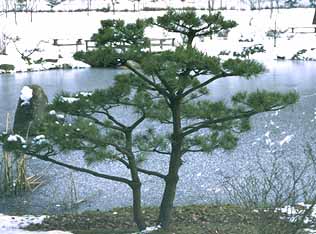 Japanese Red Pine (Pinus densiflora) 40 to 60 ft tall, 40 to 60 ft spread (large tree) Another tree that needs to be placed close to enjoy. And even better if you plant a multi-trunk specimen. Needs some care to establish since pines like acid soil and Oklahoma is mostly alkaline, but well worth the trouble to start. Very drought tolerant (once established) and a very well behaved and elegant tree. The bark exfoliates to reveal a trunk made up of about a jillion shades of red to orange (yeah, I didn't realize there were that many shades until I saw my first Japanese Red Pine either).
Japanese Red Pine (Pinus densiflora) 40 to 60 ft tall, 40 to 60 ft spread (large tree) Another tree that needs to be placed close to enjoy. And even better if you plant a multi-trunk specimen. Needs some care to establish since pines like acid soil and Oklahoma is mostly alkaline, but well worth the trouble to start. Very drought tolerant (once established) and a very well behaved and elegant tree. The bark exfoliates to reveal a trunk made up of about a jillion shades of red to orange (yeah, I didn't realize there were that many shades until I saw my first Japanese Red Pine either). Lacebark Elm (Ulmus parvifolia) 40 to 60 ft tall, 30 to 40 ft spread (large tree) A tree that needs to be given room but also needs to be enjoyed close up. An elegant shade tree, the true glory is the exfoliating bark that begins fairly young in the tree's life and just gets better with age. The bark flakes away to reveal a rainbow of colors. Drought tolerant when established, accepting of less than ideal conditions and, so far, apparently resistant to Dutch Elm disease.
Lacebark Elm (Ulmus parvifolia) 40 to 60 ft tall, 30 to 40 ft spread (large tree) A tree that needs to be given room but also needs to be enjoyed close up. An elegant shade tree, the true glory is the exfoliating bark that begins fairly young in the tree's life and just gets better with age. The bark flakes away to reveal a rainbow of colors. Drought tolerant when established, accepting of less than ideal conditions and, so far, apparently resistant to Dutch Elm disease.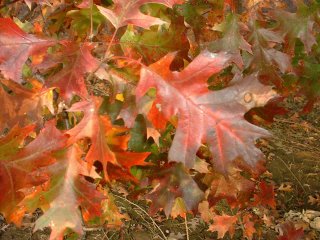 Shumard Oak (Quercus shumardi) 80 to 100 ft tall, 50 to 60 ft spread (large tree) One of the best oaks for Oklahoma. Tolerates clay soil, tolerates alkaline soil (doesn't like it, but tolerant), beautiful red-orange fall color. For all those who planted Pin oaks and are unhappy, pull them out and plant a Shumard. If you want an oak for shade and looks, plant a Shumard. Anywhere you have room, plant a Shumard!
Shumard Oak (Quercus shumardi) 80 to 100 ft tall, 50 to 60 ft spread (large tree) One of the best oaks for Oklahoma. Tolerates clay soil, tolerates alkaline soil (doesn't like it, but tolerant), beautiful red-orange fall color. For all those who planted Pin oaks and are unhappy, pull them out and plant a Shumard. If you want an oak for shade and looks, plant a Shumard. Anywhere you have room, plant a Shumard!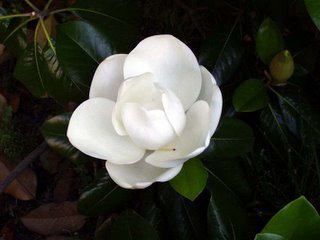 Southern Magnolia (Magnolia grandifolia) 20 to 60 ft tall, to 50 ft spread (large tree) Sometimes a little hard to establish in Oklahoma, especially in newer areas, needs acidic soil and plenty of room. But the flowers make up for the trouble and the beautiful form takes me back to my childhood. Evergreen. Little Gem is a smaller and more narrow cultivar that still has the flowers and scent of the parent plant.
Southern Magnolia (Magnolia grandifolia) 20 to 60 ft tall, to 50 ft spread (large tree) Sometimes a little hard to establish in Oklahoma, especially in newer areas, needs acidic soil and plenty of room. But the flowers make up for the trouble and the beautiful form takes me back to my childhood. Evergreen. Little Gem is a smaller and more narrow cultivar that still has the flowers and scent of the parent plant.Shrubs
 Beautyberry (Callicarpa americana) 6 ft tall, 5 ft spread (medium shrub) In spring the flowers sent out a heavenly scent. In summer, the leaves are a medium green that makes a wonderful backdrop for annuals and perennials. But in the fall, after leaf drop, beautyberry comes into its name. The fruit of the beautyberry is a small metallic purple berry that covers the stems, drawing eyes and birds alike.
Beautyberry (Callicarpa americana) 6 ft tall, 5 ft spread (medium shrub) In spring the flowers sent out a heavenly scent. In summer, the leaves are a medium green that makes a wonderful backdrop for annuals and perennials. But in the fall, after leaf drop, beautyberry comes into its name. The fruit of the beautyberry is a small metallic purple berry that covers the stems, drawing eyes and birds alike.
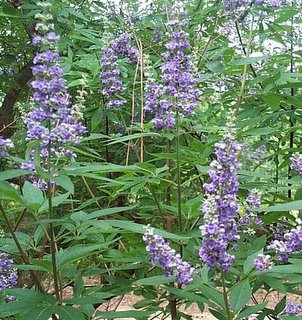 Chaste tree (Vitex agnus-castus) 6 to 20 ft tall, 6 to 15 ft spread (large shrub, small tree) For some reason, I can't grow a butterfly bush, but the chaste tree is a wonderful substitute. It flowers all summer long, the flowers attract more butterflies than you can count and when you limb the plant up it adds the most interesting architectural advantage.
Chaste tree (Vitex agnus-castus) 6 to 20 ft tall, 6 to 15 ft spread (large shrub, small tree) For some reason, I can't grow a butterfly bush, but the chaste tree is a wonderful substitute. It flowers all summer long, the flowers attract more butterflies than you can count and when you limb the plant up it adds the most interesting architectural advantage.
 Beautyberry (Callicarpa americana) 6 ft tall, 5 ft spread (medium shrub) In spring the flowers sent out a heavenly scent. In summer, the leaves are a medium green that makes a wonderful backdrop for annuals and perennials. But in the fall, after leaf drop, beautyberry comes into its name. The fruit of the beautyberry is a small metallic purple berry that covers the stems, drawing eyes and birds alike.
Beautyberry (Callicarpa americana) 6 ft tall, 5 ft spread (medium shrub) In spring the flowers sent out a heavenly scent. In summer, the leaves are a medium green that makes a wonderful backdrop for annuals and perennials. But in the fall, after leaf drop, beautyberry comes into its name. The fruit of the beautyberry is a small metallic purple berry that covers the stems, drawing eyes and birds alike. Chaste tree (Vitex agnus-castus) 6 to 20 ft tall, 6 to 15 ft spread (large shrub, small tree) For some reason, I can't grow a butterfly bush, but the chaste tree is a wonderful substitute. It flowers all summer long, the flowers attract more butterflies than you can count and when you limb the plant up it adds the most interesting architectural advantage.
Chaste tree (Vitex agnus-castus) 6 to 20 ft tall, 6 to 15 ft spread (large shrub, small tree) For some reason, I can't grow a butterfly bush, but the chaste tree is a wonderful substitute. It flowers all summer long, the flowers attract more butterflies than you can count and when you limb the plant up it adds the most interesting architectural advantage.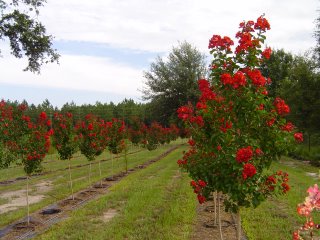 Crape myrtle (Lagerstroemia indica) 8 inches to 25 ft tall, variable spread, (small shrub to medium tree) Everyone knows the crape myrtle. Beautiful summer flowers, interesting bark, good fall color, drought tolerant (when established), no pests. What's not to love? Now you can find all sizes and a rainbow of colors.
Crape myrtle (Lagerstroemia indica) 8 inches to 25 ft tall, variable spread, (small shrub to medium tree) Everyone knows the crape myrtle. Beautiful summer flowers, interesting bark, good fall color, drought tolerant (when established), no pests. What's not to love? Now you can find all sizes and a rainbow of colors.Redtwig dogwood (Cornus alba) 10 ft tall, 10 ft spread  (medium shrub) Redtwig dogwood comes into its own in the winter. Yes the leaves are beautiful, yes the flowers are attractive, yes the berries draw birds. But in the winter you see those amazing red stems and if you are lucky enough to have a sleet storm it will have an architectural interest to beat anything else. And besides what do you have to do after a sleet storm anyway? You don't want to get out on the roads! Kesselringii cultivar has dark purple, almost black stems and red and purple fall color.
(medium shrub) Redtwig dogwood comes into its own in the winter. Yes the leaves are beautiful, yes the flowers are attractive, yes the berries draw birds. But in the winter you see those amazing red stems and if you are lucky enough to have a sleet storm it will have an architectural interest to beat anything else. And besides what do you have to do after a sleet storm anyway? You don't want to get out on the roads! Kesselringii cultivar has dark purple, almost black stems and red and purple fall color.
 (medium shrub) Redtwig dogwood comes into its own in the winter. Yes the leaves are beautiful, yes the flowers are attractive, yes the berries draw birds. But in the winter you see those amazing red stems and if you are lucky enough to have a sleet storm it will have an architectural interest to beat anything else. And besides what do you have to do after a sleet storm anyway? You don't want to get out on the roads! Kesselringii cultivar has dark purple, almost black stems and red and purple fall color.
(medium shrub) Redtwig dogwood comes into its own in the winter. Yes the leaves are beautiful, yes the flowers are attractive, yes the berries draw birds. But in the winter you see those amazing red stems and if you are lucky enough to have a sleet storm it will have an architectural interest to beat anything else. And besides what do you have to do after a sleet storm anyway? You don't want to get out on the roads! Kesselringii cultivar has dark purple, almost black stems and red and purple fall color. Rose-of-Sharon (Hibiscus syriacus) 8 to 10 ft tall, 3 to 5 ft spread (medium shrub) Blooms all summer long, and you can pick your color! Reds, pinks, whites, bi-colors, close to blue and some talk of true blues coming, though I haven't seen one. Drought tolerant (once established), flower litter may be a slight problem on pavements, but all together a wonderful plant.
Rose-of-Sharon (Hibiscus syriacus) 8 to 10 ft tall, 3 to 5 ft spread (medium shrub) Blooms all summer long, and you can pick your color! Reds, pinks, whites, bi-colors, close to blue and some talk of true blues coming, though I haven't seen one. Drought tolerant (once established), flower litter may be a slight problem on pavements, but all together a wonderful plant. Rusty Blackhaw Viburnum (Viburnum rufidulum) 15 to 18 ft tall, 15 to 20 ft spread (large shrub, medium tree) This is one of my favorite natives. Somewhat hard to find in the trade, but one of the best viburnums you'll ever see. Good wildlife tree, fragrant flowers, blue-black berries, wine-red fall color. Tough and hardy.
Rusty Blackhaw Viburnum (Viburnum rufidulum) 15 to 18 ft tall, 15 to 20 ft spread (large shrub, medium tree) This is one of my favorite natives. Somewhat hard to find in the trade, but one of the best viburnums you'll ever see. Good wildlife tree, fragrant flowers, blue-black berries, wine-red fall color. Tough and hardy. Sweetbox (Sarcococca hookeriana) 6 ft tall, 4 ft spread (medium shrub) If you have ever planted boxwood and were disappointed (because of spider mites, winter dieback, and don't get me started on that smell) sweetbox is your answer. It does well in shade, grows slowly (so plant on the close side of the spread but less maintenance) and in the early spring, the small unnoticeable flowers will release their violet scent and make you fall in love.
Sweetbox (Sarcococca hookeriana) 6 ft tall, 4 ft spread (medium shrub) If you have ever planted boxwood and were disappointed (because of spider mites, winter dieback, and don't get me started on that smell) sweetbox is your answer. It does well in shade, grows slowly (so plant on the close side of the spread but less maintenance) and in the early spring, the small unnoticeable flowers will release their violet scent and make you fall in love.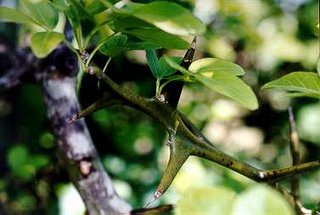 Trifoliate Orange (Poncirus trifoliata) 15 to 25 ft tall, 10 to 15 ft spread (large shrub, small tree) One of my particular favorites, especially the Flying Dragon cultivar, which has twisting stems. Trifoliate orange is the only citrus that is hardy in Oklahoma. The flowers in spring have the distinctive orange blossom scent and the fruit is attractive to birds and squirrels, once they figure it out. The branches are armed with very sharp spines which make this an excellent plant for security plantings. As with all spined plants, limit human contact, and believe me, you'll want to limit pruning to only the necessary.
Trifoliate Orange (Poncirus trifoliata) 15 to 25 ft tall, 10 to 15 ft spread (large shrub, small tree) One of my particular favorites, especially the Flying Dragon cultivar, which has twisting stems. Trifoliate orange is the only citrus that is hardy in Oklahoma. The flowers in spring have the distinctive orange blossom scent and the fruit is attractive to birds and squirrels, once they figure it out. The branches are armed with very sharp spines which make this an excellent plant for security plantings. As with all spined plants, limit human contact, and believe me, you'll want to limit pruning to only the necessary.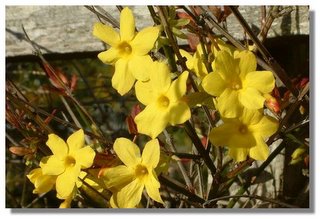 Winter jasmine (Jasminum nudiflorum) 10 ft tall, 10 ft spread (medium shrub) This is a great shrub if you have some place where it can ramble. The height and spread numbers are somewhat misleading since it colonizes and fills any available space. When I told my dean at OSU/OKC that I had winter jasmine he got excited and wanted some. I went out and dug half a dozen sprigs out of the mulch and now the greenhouse has 20 or 30 pots of it! Blooms in winter all over bare stems with the true jasmine scent, a bright yellow reminder that spring is coming sooner or later.
Winter jasmine (Jasminum nudiflorum) 10 ft tall, 10 ft spread (medium shrub) This is a great shrub if you have some place where it can ramble. The height and spread numbers are somewhat misleading since it colonizes and fills any available space. When I told my dean at OSU/OKC that I had winter jasmine he got excited and wanted some. I went out and dug half a dozen sprigs out of the mulch and now the greenhouse has 20 or 30 pots of it! Blooms in winter all over bare stems with the true jasmine scent, a bright yellow reminder that spring is coming sooner or later. Witch hazel (Hamamelis vernalis 'Sandra) 15 ft tall, 15ft spread (large shrub) Witch hazel is not often planted in this area, and I'm not sure why. Flowers in late winter (usually January in Oklahoma) and profusely, and they smell great. Sandra has new leaves in purple and in fall the leaves turn red, yellow and purple.
Witch hazel (Hamamelis vernalis 'Sandra) 15 ft tall, 15ft spread (large shrub) Witch hazel is not often planted in this area, and I'm not sure why. Flowers in late winter (usually January in Oklahoma) and profusely, and they smell great. Sandra has new leaves in purple and in fall the leaves turn red, yellow and purple. 

0 Comments:
Post a Comment
<< Home